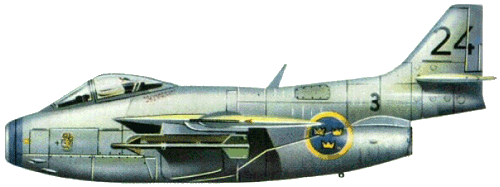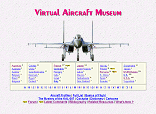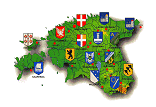Aircraft Profile #36. Saab J.29 |
|
|
During W.W.II Sweden experienced a degree of technical isolation, for all aeronautical engineering progress achieved abroad was carefully shrouded in so far as it possessed any military value. Towards the end of the war many of the engineers employed at Svenska Aeroplan A.B. (SAAB} were aware that they had fallen behind in aeronautical progress, particularly in the field of jet propulsion, in which both the British and Germans had carried out secret development on a large scale. The results of this work were disclosed suddenly at the end of the war with the appearance of several types of jet aircraft, which were superior to all contemporary propeller-driven types. SAAB made strenuous efforts to catch the leaders in the jet propulsion race, and they achieved a great deal despite the lack of suitable research facilities. Certain resources were available and a number of prominent Swedish engineers were working on design studies although no actual development work had taken place. The view held then was that the practical application of the system belonged to the future. On the initiative of the Swedish Air Force, however, the design of jet engines was undertaken by a number of Swedish companies, and in the spring of 1945, SAAB was commissioned to investigate
PRELIMINARY STUDIES The first design drawn up during this period was the RX 1. It featured twin tail booms, similar to those of the SAAB 21A and de Havilland Vampire, and was to be powered by an engine delivering some 6,000kg thrust. Maximum speed was estimated at 740km/h. The Swedish companies concerned with the design of jet engines at this period were Svenska Flygmotor AB (SFA), AB Lundstroms Angturbin (ALA/AB) and Svenska Turbinfabrike AB Ljungstrom (STAL). Another SAAB design of the period was a development of the RX 1 designated the RX 2 "Merry Widow". In the autumn of 1945 the first SAAB design on more detailed lines was revealed and was known as the R 101. Its appearance could be likened to the well-known Lockheed F-80 Shooting Star, of which SAAB had no knowledge at that lime. When the design reached the stage when more detailed development was to be proceeded with, illustrations and a description was published of the Shooting Star, which was in series production. It was obvious lhat the entire SAAB design was bordering on obsolescence and there was little prospect of overtaking the lead gained by other manufacturers. As a result the R 101 was
SWEDEN'S FIRST JET During autumn 1945 it was decided that a jet propelled version of the SAAB 21A (J 21A) should be produced. At that time the de Havilland Goblin jet engine was released for export and some examples were purchased, one being installed in a conversion of the 21A designation SAAB 21R (J 21R). The prototype 21R flew for the first time on 10th March 1947 and a total of sixty were later delivered to the Swedish Air Force. Having established and produced a stop-gap jet fighter, SAAB were now able to give full attention to designing a jet fighter of advanced configuration. "BARREL" DEVELOPMENT The first scheme for a new type of jet aircraft was drawn up at the end of October 1945, and the power-plant specified was the de Havilland Goblin engine with a thrust of approximately 1400kg mounted immediately behind the centre of the fuselage. The pilot was seated above a single, straight air duct, producing a deep fuselage, and in order to keep the high speed profile wing free from cut-outs the retractable landing gear was located in the fuselage sides, thus imparting a circular
For reasons of stability the tail boom supporting the empennage was lengthened beyond the lower, shortened section of the fuselage in which the engine exhaust was located. This enabled the full landing angle to be obtained with the low-positioned undercarriage. Notwithstanding certain aesthetic imperfections, the many obvious advantages of the aircraft aroused the interest of the Swedish Air Force and work on the design was proceeded with experimentally. But certain events took place which were to result in a revised programme by the SAAB team. First, technical information from de Havillands in England was obtained relating to a larger engine - the Ghost - which was undergoing development, and which was estimated to produce a thrust or 2270kg. It was obvious that such a powerful engine would enable SAAB to design and produce a far more advanced fighter, and after negotiations between de Havillands and the Swedish Air Force SAAB was able to incorporate the engine in the new design. It was discovered that the relatively large diameter of the engine (approximately 1.35m) was ideal for the fuselage dimensions, these being desirable for many reasons. The fact that the engine could also be fed via a central, circular air intake rendered it eminently
Secondly, the SAAB engineers were able to obtain first-hand access to an immense quantity of experimental material devoted to high speed flight accumulated by German scientists during the war. This related primarily to the phenomena of drag and lift approaching sonic speed, and the possibilities of improving the performance of an aircraft in the higher speed range by the use of swept wings. This information led SAAB designers to select a wing with a moderate sweep back of 25 degrees combined with a thin profile. From the experimental material it was also possible to calculate how slender the fuselage should be in order that its critical Mach number should not reduce the advantages gained with the wing. The first "final" design sketches drawn during January 1946 incorporated all the new information, and the resultant aeroplane was of advance configuration. PROJECT WORK – R 1001 With the new design it now seemed that SAAB was able to produce a fighter of such advanced performance that it would remain in service for a considerable period. SAAB estimated that a speed of "considerably exceeding 1,000km/h" could be attained. The main outline was thus clear by February 1946, and the Swedish Air Force now requested that actual work
The wind tunnel tests were started at the Royal University of Technology and the Aeronautical Research Institute, both in the low and high speed tunnels, a number of modified models being subsequently tested and the aircraft shape subjected to final modifications. In order to give the new fighter the best conceivable lateral stability at take-off and touch-down, automatic slots were introduced on the outer wing section. These were to be interconnected with the flaps so that they were extended with the latter in the take-off and landing positions, but were automatically locked closed with the flaps retracted for high speed flight. To test the new system "Aircraft 201” was constructed; this was a converted SAAB 91A Safir fitted with a half-scale wing of the R 1001. In the autumn of 1946 all main questions of principle had been solved and a
FINAL DESIGN An experimental mock-up of the front portion of the SAAB 29 was constructed in order to test various sealing materials for the pressurised cabin, and after various attempts leakage was reduced to an acceptable maximum. A new innovation for SAAB was the introduction of servo-controlled ailerons. During the summer of 1948 the complete aileron system was tested in a special rig and as these tests appeared to be satisfactory it was expected that the first prototype J 29 (29 001) would fly before 1st August that year. But the servo system developed serious faults, and it was several weeks before these faults were traced and corrected; it was not until the end of August that the prototype was ready for initial taxiing tests. Test pilot, Squadron Leader Robert Moore, was in charge of the flying end of the test programme, and in the accepted sequence of events he made several short hops during the taxiing tests. All systems then
The two first prototypes lacked armament but carried heavy test equipment, while the third prototype carried four 20mm automatic guns. The fourth, and final, prototype (29 004) was flown in 1950. THE J-29 VARIANTS J29A First version of the SAAB 29 to be built in quantity was the J 29A. The first sixteen (29 101 to 29 116) had trim tabs and wing dive brakes. Aircraft 29 117 to 29 132 also featured trim tabs and wing dive brakes, but subsequent aircraft had the dive brakes mounted in the fuselage sides forward of the landing gear doors. A total of 224 J 29As were built and delivered to the Swedish Air Force during
During June 1946 the F 13 Wing at Norrkoping began converting to the J 28A (Vampire FB Mk.I), the Swedish Air Force's first jet fighter. The J 28A was replaced by the J 29A as from May 1951, but the new fighter was not approved by the Air Force until January 1952. By that time it had survived intensive service tests in different climatic environments. In 1960 the F 13 Wing received the J 35A "Draken", but the last J 29A served until 1962. Deliveries of the J 29A continued and in 1952 the F 9 Wing at Goteborg converted from the J 28B (Vampire FB Mk.50) to the new lighter. Same of the J 29As served with the Wing until 1962. In 1956 the F 9 Wing also received the up-rated F conversion. The F 12 Wing, stationed near Kalmar, converted from the J 21A to the 29A in 1952, and the last of the 29As were replaced by the J 32B Lansen in 1960. The F 16 and F 20 Wings took delivery of a quantity of J 29s in 1952 and these were phased out of service in 1963. The F 3 Wing converted from J 28As to J
A number of J 29As equipped the F 8 Wing at Barkarby from 1954, and the last remaining A conversion was still flying with F 8 in 1965. J 29B The B conversion differed little from the A, the main modification being extra fuel tanks installed in the wing, increasing the 1,400 litre to 2100 litre (internal). The J 29B was used as an attack aircraft and for this purpose could be equipped with rockets and napalm bombs. The first B prototype was flown on March 11th 1953 and during 1954 the B model set up a world air speed record of an average of 977km/h over a 500km closed circuit. A total of 332 J 29Bs (or A 29 (A-attack) as it was designated) were built and delivered during the period May 1953 to December 1955. Two hundred and eighty-nine J 29Bs were converted to the J 29F configuration. During 1953 the F6 Wing at Karlsborg converted from the A 21A to the A 29B, the
The F 8 Wing at Barkarby received the 29B in 1953, and from 1955 it served parallel with the J 34 (Hunter F.4) until 1964. Another Attack Wing to receive the A 29B was the F 7 Wing at Satenas. The Wing's A 21Rs were replaced by the 29B in 1954, the latter serving for two years before being replaced themselves by the A 32A. S29C On 3rd June 1953 the first prototype (29 901) of a new photo-reconnaissance plane made its first flight. This was the SAAB 29C which was given the designation S 29C by the Swedish Air Force. During the period May 1954 to May 1956 a total of 76 29Cs were built and delivered, and the type was basically similar to its immediate predecessor with the exception of the fuselage nose section, which was modified to accept the installation of seven cameras. A new international speed record over a 1000km closed circuit was established by a flight of two S 29Cs in 1955. The F 11 Wing in Nykoping took delivery of the first 29Cs during August 1953 as replacements for their S 31S {Spitfire Mk.19s), but the SAAB machine did not receive Air Force approval
The F 21 Wing at Lulea converted from the S 26 (photo-reconnaissance version of the Mustang fighter) in 1954, and in late 1965 the 29C was still serving in parallel with the J 32B. Originally the S 29C had the same wing as the J 29A and B, but this was modified to E/F standards ("Dog tooth" leading edge). An external antenna for backwards-looking radar was originally installed in ihe tail cone, but this was later relocated in the fuselage. SAAB 29D Parallel with the licence-production of the de Havilland Ghost engine, Svenska Flygmotor AB (SFA) developed an afterburner which was installed in a standard J 29B (29 325) airframe. After a period of flight and other tests, during which it was designated the SAAB 29D, the aircraft was converted to J 29F standard and delivered to the Air Force. J 29E During the same period when tests on the SAAB 29D were taking place work was also proceeding on a modified wing shape intended to raise the critical Mach number of the J 29. The first aircraft to be fitted with the new wing was designated the
J 29F The J 29F was the last variant of the Flying Barrel design and it differed from previous versions in many respects. The most noticeable modification was the introduction of the afterburner developed by the Royal Swedish Air Board in cooperation with SFA and flight tested in the SAAB 29D. The afterburner increased thrust of the Swedish-built Ghost engine by a considerable margin, and it is interesting to note that the SFA afterburner was the first to be successfully used with a British jet engine. The 29F prototype flew for the first time on 20th March 1954 and was fitted with the modified wing as standardised on the 29E. A total of 210 J 29B/Es were modified by SAAB to F standard and delivered between February 1955 and May 1958. A further 98 aircraft were modified to F standard by the Central Workshop
The first unit to re-equip with the new 29F was the F 3 Wing at Malmslatt and it served with this Wing until 1965, when replaced by the J 35 Draken. The F4 Wing received the J 29F in 1956 and the aircraft was still front-line equipment in 1965. During 1956 both the F 9 and F 10 Wings were equipped with the J 29F. The former Wing operated their machines until 1963 when they converted to the J 34 (the aircraft being transferred from the F 8 and F 18 Wings). A number of J 29Fs were still serving alongside J 35Ds with F 10 in 1965. The F 15 Wing at Soderham converted from the J 28B to the J 29F during 1957, and the latter served with this Wing until 1961 when it re-equipped with the A 32A and became an attack unit. The F 16 and F 20 Wings at Uppsala successively equipped with the J 29F and a number of them were still serving with these units in 1965. From the end of 1963 all 29Fs in front-line service were equipped with the American Sidewinder infra-red seeking missile (Rb 24),
A total of 661 SAAB 29s were constructed and delivered from May 1951 to May 1956, and of these 308 (29B and Es) were converted to J 29F standards. In 1965 two Air Force Units were still equipped with the 29F as front-line types, and two reconnaissance units, F 11 and F 21, were still operating the S 29C. FOREIGN SERVICE In 1961, following an appeal by the United Nations, the Swedish Government sent five J 29Bs to the Congo to provide support and cover for the UNO ground forces. The Swedish UN unit was called the F 22 Voluntary Air Component and the 29Bs carried the legend "UN" in black on a large, while, square background. The 29Bs were equipped with eight 140mm rockets and could also carry two jettisonable fuel tanks under the wings. The J 29Bs were the only combat aircraft at UNO's disposal in the Congo following the withdrawal of Indian Canberras and Ethiopian Sabres and in October 1962 two S 29C reconnaissance fighters joined the original detachment. The story of F 22 began on 24th September 1961 when the Swedish Government placed the J 29 fighter bombers at UNO's disposal, and the aircraft and personnel arrived
FOREIGN DELIVERIES On 27th January 1961 the Swedish Government granted the Air Board permission to sell 15 J 29Fs to SAAB for delivery to Austria. The amount was 8 050 000 Sw crowns. The 15 aircraft were restored at SAAB and delivered to the Austrian Air Force, forming the first Jagdbomber Staffel. In 1962 the Air Board received Swedish Government permission to sell a further 15 J 29Fs to Austria. The amount was 7 700 000 Sw Crowns. These aircraft were restored and specially converted by AB Svenska Flygverkstaderna in Malmo. Instead of the two guns in the port side of the nose three cameras could be mounted in a special capsule. The cameras were movable in different directions from trie cockpit during flight. The exchange of equipment took about 30 minutes. The second batch of 15 J 29Fs equipped the second Jagdbomber-Staffel of the Austrian Air Force. (C) Bo Widfeidt, 1965 |
 All the World's Rotorcraft
|
















